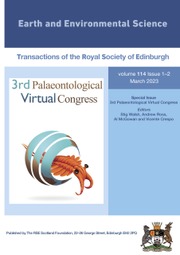Crossref Citations
This article has been cited by the following publications. This list is generated based on data provided by
Crossref.
Janensch, Werner
1952.
Über den Unterkiefer der Therapsiden.
Paläontologische Zeitschrift,
Vol. 26,
Issue. 3-4,
p.
229.
Parrington, F.R.
1953.
LXXII.—OnAenigmasaurus grallator, gen. et sp. nov., a problematic reptile from the L. Trias.
Annals and Magazine of Natural History,
Vol. 6,
Issue. 70,
p.
721.
Watson, D. M. S
1953.
THE EVOLUTION OF THE MAMMALIAN EAR.
Evolution,
Vol. 7,
Issue. 2,
p.
159.
Parrington, F. R.
1955.
On the cranial anatomy of some gorgonopsids and the synapsid middle ear..
Proceedings of the Zoological Society of London,
Vol. 125,
Issue. 1,
p.
1.
Cromptok, A. W.
and
Parrington, F. R.
1955.
On some Triassic cynodonts from Tanganyika.
Proceedings of the Zoological Society of London,
Vol. 125,
Issue. 3-4,
p.
617.
CROMPTON, A. W.
and
Museum, S. A.
1958.
THE CRANIAL MORPHOLOGY OF A NEW GENUS AND SPECIES OF ICTIDOSAURAN.
Proceedings of the Zoological Society of London,
Vol. 130,
Issue. 2,
p.
183.
COX, C. B.
1959.
ON THE ANATOMY OF A NEW DICYNODONT GENUS WITH EVIDENCE OF THE POSITION OF THE TYMPANUM.
Proceedings of the Zoological Society of London,
Vol. 132,
Issue. 3,
p.
321.
CROMPTON, A. W.
and
PARKYN, D. G.
1963.
ON THE LOWER JAW OF DIARTH ROGN ATHUS AND THE ORIGIN OF THE MAMMALIAN LOWER JAW.
Proceedings of the Zoological Society of London,
Vol. 140,
Issue. 4,
p.
697.
Romer, Alfred Sherwood
1967.
EARLY REPTILIAN EVOLUTION RE-VIEWED.
Evolution,
Vol. 21,
Issue. 4,
p.
821.
Gow, C. E.
1972.
The osteology and relationships of the Millerettidae (Reptilia: Cotylosauria).
Journal of Zoology,
Vol. 167,
Issue. 2,
p.
219.
1979.
The primitive cynodontProcynosuchus: functional anatomy of the skull and relationships.
Philosophical Transactions of the Royal Society of London. B, Biological Sciences,
Vol. 285,
Issue. 1005,
p.
73.
1980.
The primitive cynodontProcynosuchus:: structure, function and evolution of the postcranial skeleton.
Philosophical Transactions of the Royal Society of London. B, Biological Sciences,
Vol. 288,
Issue. 1027,
p.
217.
Hopson, James A.
1995.
Patterns of evolution in the manus and pes of non-mammalian therapsids.
Journal of Vertebrate Paleontology,
Vol. 15,
Issue. 3,
p.
615.
LEE, MICHAEL S. Y.
1995.
Historical Burden In Systematics And The Interrelationships Of ‘Parareptiles’.
Biological Reviews,
Vol. 70,
Issue. 3,
p.
459.
Gubin, Y.M.
1997.
Skull morphology ofArchegosaurus decheniGoldfuss (Amphibia, Temnospondyli) from the Early Permian of Germany.
Alcheringa: An Australasian Journal of Palaeontology,
Vol. 21,
Issue. 2,
p.
103.
RAY, SANGHAMITRA
2001.
Small Permian dicynodonts from India.
Paleontological Research,
Vol. 5,
Issue. 3,
p.
177.
DAMIANI, ROSS J.
2001.
A systematic revision and phylogenetic analysis of Triassic mastodonsauroids (Temnospondyli: Stereospondyli).
Zoological Journal of the Linnean Society,
Vol. 133,
Issue. 4,
p.
379.
Ray, Sanghamitra
and
Bandyopadhyay, Saswati
2003.
Late Permian vertebrate community of the Pranhita–Godavari valley, India.
Journal of Asian Earth Sciences,
Vol. 21,
Issue. 6,
p.
643.
BOTHA, J.
ABDALA, F.
and
SMITH, R.
2007.
The oldest cynodont: new clues on the origin and early diversification of the Cynodontia.
Zoological Journal of the Linnean Society,
Vol. 149,
Issue. 3,
p.
477.
ABDALA, FERNANDO
2007.
REDESCRIPTION OF PLATYCRANIELLUS ELEGANS (THERAPSIDA, CYNODONTIA) FROM THE LOWER TRIASSIC OF SOUTH AFRICA, AND THE CLADISTIC RELATIONSHIPS OF EUTHERIODONTS.
Palaeontology,
Vol. 50,
Issue. 3,
p.
591.

